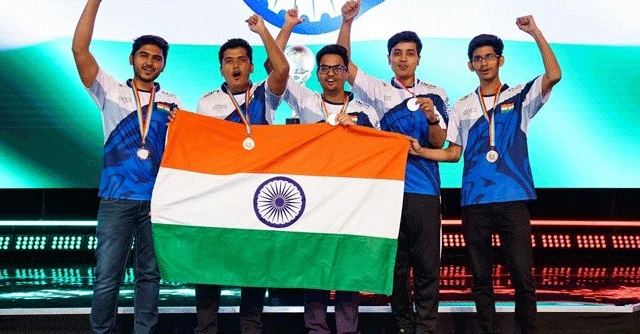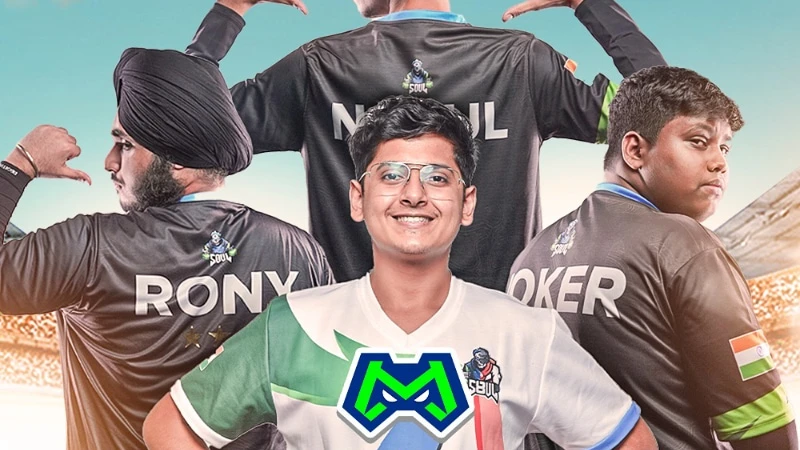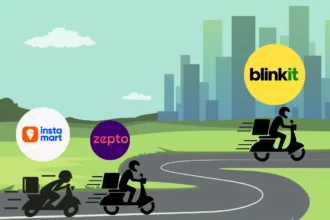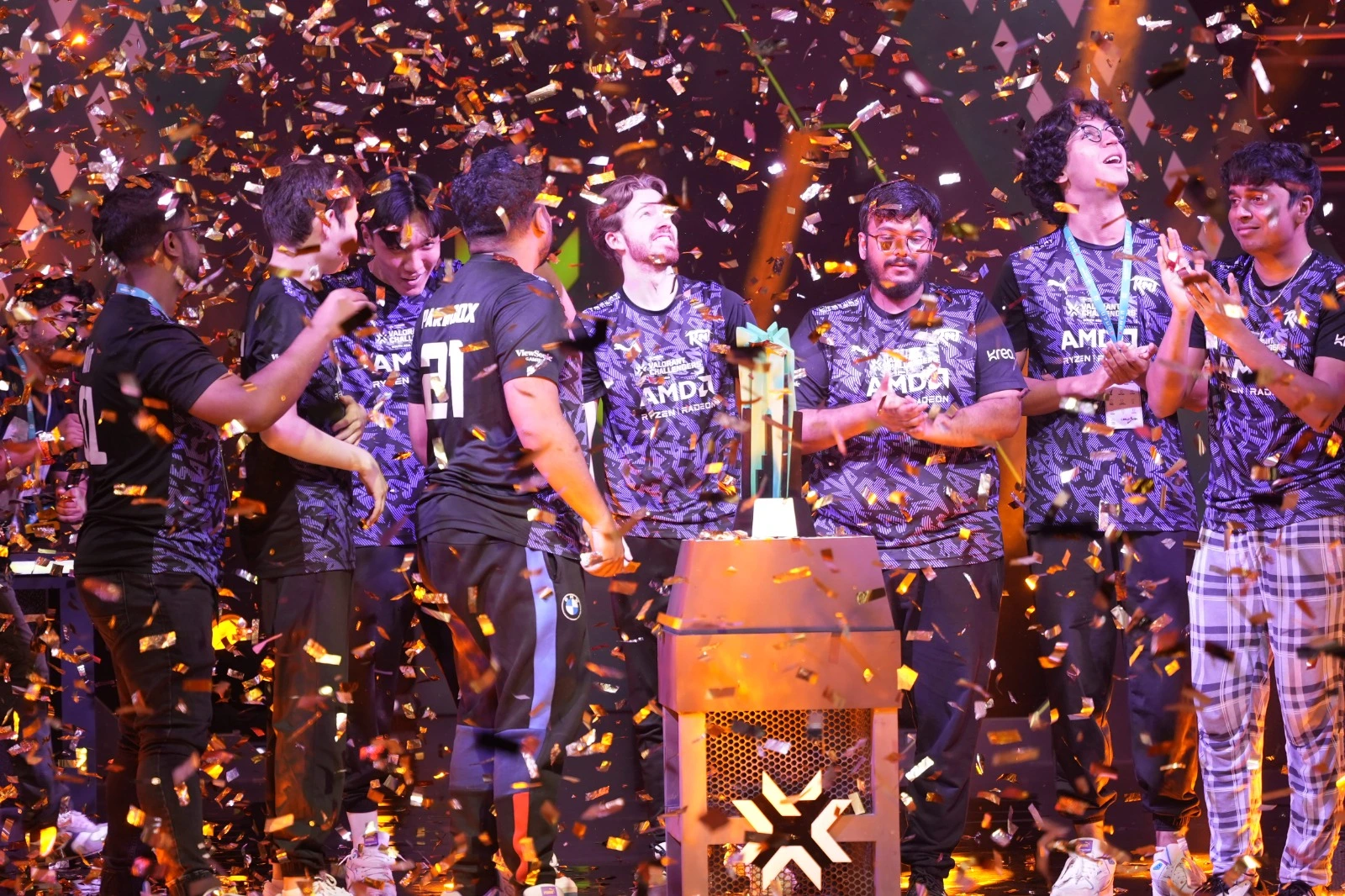Estimated Reading Time: 16-20 minutes (3,462 words)
Introduction
Esports in India is no longer a fringe hobby — it has transformed into one of the fastest-growing segments of the entertainment and competitive gaming landscape. Backed by a young digital-first population, cheap mobile data, and an explosion of gaming titles like BGMI, Valorant, and Free Fire Max, India has become one of the world’s most dynamic esports markets. What was once seen as casual gaming has evolved into a structured sport with leagues, coaches, analysts, sports psychologists, and multimillion-rupee prize pools. This shift has also attracted major consumer brands, telecom companies, smartphone giants, and fintech startups looking to tap into India’s massive gaming audience.
As the Indian esports market surges, a handful of homegrown organizations are leading the way — not just dominating local tournaments but also making a mark internationally. These teams have built competitive rosters, strong talent pipelines, and diversified businesses that include content houses, training facilities, and global collaborations. For Indian gamers, they’ve become aspirational career pathways; for brands, they represent some of the country’s most engaged communities; and for the industry, they signal how quickly India is maturing into a global esports contender.
Whether you’re a brand evaluating sponsorships, a gamer aspiring to go pro, or a fan scouting the next breakout roster, understanding the top esports teams in India is essential. In this blog, we’ll break down the leading Indian esports organizations to watch in 2025, explore their strategies, analyse their competitive strengths, and explain why their growth matters — all against the backdrop of India’s booming esports economy and its promising global trajectory.

India’s Esports Landscape: Market & Growth Trends
- Strong Market Growth:
- IMARC values India’s esports market at USD 200.7 million (2024).
- Expected CAGR: 18.40% from 2025–2033, placing India among the world’s fastest-growing esports markets.
- IMARC values India’s esports market at USD 200.7 million (2024).
- Future Market Value:
- Grand View Research estimates the market will reach USD 307.2 million by 2030.
- Sponsorships remain the largest revenue driver for esports orgs.
- Media rights (YouTube, Rooter, JioCinema) are the fastest-growing segment.
- Grand View Research estimates the market will reach USD 307.2 million by 2030.
- Rapid Audience Expansion:
- Statista projects 147.9 million esports-interested users in India by 2029.
- Growth driven by mobile penetration, cheaper data, and 5G rollout.
- Statista projects 147.9 million esports-interested users in India by 2029.
- Player Participation Is Skyrocketing:
- Per Economic Times: esports athletes increased from 150,000 (2021) to ~600,000 (2022).
- Expected to reach 1.5 million players by 2027.
- Per Economic Times: esports athletes increased from 150,000 (2021) to ~600,000 (2022).
- Prize Pools & Industry Value:
- EY reports India’s esports prize pool is growing at 66% CAGR, projected to reach ₹1 billion (~USD 12M) by 2025.
- Broader esports industry value (events + content + teams) could hit ₹11 billion.
- EY reports India’s esports prize pool is growing at 66% CAGR, projected to reach ₹1 billion (~USD 12M) by 2025.
- Market Drivers:
- Affordable smartphones, publisher support, local tournaments, global collaborations.
- Shift from casual gaming to structured leagues with coaches, analysts, and sports science.
- Affordable smartphones, publisher support, local tournaments, global collaborations.
- Why This Matters:
- The surge in users, players, prize pools, and brand investment creates a fertile environment for Indian esports teams to scale.
- The surge in users, players, prize pools, and brand investment creates a fertile environment for Indian esports teams to scale.
Teams are evolving from simple gaming lineups to full-fledged sports and entertainment businesses with global ambitions.
Why Indian Esports Teams Matter
Talent pipeline & youth engagement:
With over 50% of India’s population under the age of 30, esports has become a powerful career pathway for digitally native youth. Unlike traditional sports, esports offers a low entry barrier, requiring only a smartphone or PC, which has enabled millions to participate. This has created one of the largest talent pipelines in Asia, with structured academies, scouting programs, and junior rosters now grooming young players into professional athletes. For many, esports represents not just competition, but an avenue for scholarships, streaming careers, and international exposure.
Brand and sponsor alignment:
Indian esports teams are becoming prime assets for non-endemic brands—from smartphone giants and energy drink companies to FMCG, fintech, and telecom brands seeking access to India’s massive Gen Z audience. With esports boasting high engagement rates, teams are seeing long-term partnerships, co-branded merchandise, and campaign integrations that rival mainstream sports. As a result, a growing share of digital marketing budgets is flowing into esports, boosting team revenues and enabling bigger investments in infrastructure, analytics, and roster development.
Professionalization:
Top Indian esports organizations now operate with the same rigor as global teams. This includes full-time coaching staff, analysts, sports psychologists, dieticians, bootcamp facilities, and dedicated content production arms. Many teams run well-defined business units covering talent management, sponsorships, media rights, merchandising, and IP creation. This professionalization has shifted esports from casual play to a structured, well-funded sports ecosystem, ensuring better player welfare, consistent performance, and long-term sustainability.
Global relevance:
India’s top esports teams are increasingly stepping beyond regional competitions and participating in international leagues, global qualifiers, and world championships. This includes notable appearances in Valorant Champions Tour (VCT), Pokémon Unite Worlds, Free Fire World Series, COD Mobile World Championships, and more. These achievements are placing India firmly on the global esports map, attracting attention from foreign investors, publishers, and international organizations. With rising opportunities and improving competitive standards, Indian esports teams are becoming key representatives of India’s potential on the global stage.
Top Indian Esports Teams to Watch (Profiles)
Here are five Indian esports organisations leading the charge in 2025 — each with distinct strengths, roster depth, business strategies, and global ambitions.
3.1 S8UL Esports
Overview:
Formed in 2020 through the merger of Team SouL and 8bit, S8UL has become India’s most influential esports + gaming-content powerhouse. The org masterfully blends competitive teams, creator-led entertainment, and a strong community presence. It is widely regarded as the face of India’s gaming ecosystem, winning global awards for content and fan engagement.
Games / Divisions:
BGMI, Pokémon Unite, Apex Legends, Call of Duty: Mobile, Valorant, New State Mobile, and creator-driven casual divisions.
Key People:
- Naman “Mortal” Mathur – Co-founder, esports legend, and one of India’s most respected creators.
- Animesh “Thug” Agarwal – Co-founder, business operations head.
- Lokesh “Goldy” Jain – Co-founder, handles org management & partnerships.
Recent Moves:
In 2025, S8UL signed three of India’s Asian Games esports athletes to spearhead their League of Legends expansion, demonstrating a clear push into internationally competitive titles and a more globally aligned roster strategy.
Business Strengths:
- One of India’s strongest content creation ecosystems, with 20+ top creators under the S8UL umbrella.
- Operates a large gaming house in Mumbai, used for content, bootcamps, and brand shoots.
- High engagement allows for premium sponsorship deals with global brands like Krafton, Lenovo, and Monster Energy.
- Dominates both competitive esports and influencer-led entertainment — a rare dual strength in India.
3.2 Team SouL
Overview:
Team SouL is one of India’s oldest and most iconic mobile-esports organizations. Known for its emotional fanbase and consistent presence at top-tier BGMI tournaments, SouL is deeply rooted in India’s early PUBG Mobile era and continues to be a brand-defining force in 2025.
Founders / Players:
- Initially driven by MortaL (Naman Mathur), whose leadership, content reach, and sportsmanship helped SouL become a revered brand in Indian gaming.
- Many emerging BGMI talents have trained under or been inspired by SouL’s structure.
Ecosystem:
- Strong focus on coaching, in-house analytics, and structured training.
- Highly active in content — daily scrims, vlogs, bootcamp tours, roster documentaries.
- One of the strongest community-driven ecosystems, with millions of active fans across YouTube and Instagram.
Why Watch:
Team SouL’s legacy, combined with a stable content and competitive pipeline, ensures long-term sustainability. Their ecosystem continues to be a breeding ground for top pro players, making them crucial in India’s esports evolution.
3.3 GodLike Esports
Overview:
GodLike Esports has cemented itself as a dominant force in Indian mobile esports, consistently competing at the highest levels in BGMI and COD Mobile. Known for aggressive playstyle, team synergy, and a star-studded roster, GodLike maintains one of India’s strongest brand presences.
Star Player:
- Jonathan “Jonathan Gaming” Amaral — one of India’s most celebrated BGMI players, globally praised for his aim precision, consistency, and clutch performances.
Business Model:
- Strong focus on tournament performance and competitive excellence.
- Content plays a major role — daily livestreams, scrims, highlight packages, player POVs.
- Revenue streams include sponsorships, brand deals, merch drops, prize winnings, and influencer-driven monetization.
Relevance:
GodLike is known for building and nurturing elite-level rosters. Their consistency in BGMI and reputation for producing world-class mobile athletes makes them one of India’s most important esports organizations to follow in 2025 and beyond.

3.4 Velocity Gaming (VLT)
Overview:
Velocity Gaming is one of India’s most respected names in PC esports, with a strong footprint in Valorant. Their early dominance in India’s Valorant scene helped push the country into global competitive conversations, and they remain a top organization for PC-focused players.
Strengths:
- Highly skilled Valorant roster with a track record of top finishes in Indian and South Asian circuits.
- A balanced growth strategy combining competitive dominance, content creation, and brand partnerships.
- Known for stable management, disciplined training structures, and roster nurturing.
Why They Matter:
India’s esports ecosystem is slowly evolving beyond mobile gaming — and PC esports will play a critical role in global exposure. Velocity Gaming represents India’s most serious attempts at global PC esports competitiveness, making them pivotal as India aims to compete internationally.
3.5 Revenant Esports
Overview:
Revenant Esports is one of India’s rising stars, with rapid expansion across mobile and multi-title divisions. Known for ambitious recruitment and long-term planning, the org competes across BGMI, Valorant, Pokémon Unite, and Call of Duty.
Ambition:
- Active investment in grassroots talent programs, player development, and analytics.
- Focused on taking young, underrated players and turning them into polished professionals.
- Regularly participates in major domestic tournaments and global qualifiers.
Opportunity:
With the rise in team valuations, media rights, and sponsorship deals in India, Revenant sits in a strong position to scale. Their ability to maintain consistent performances, improve coaching structures, and strengthen brand visibility will determine whether they can join India’s top tier of esports giants.
How These Teams Make Money
Understanding how esports orgs generate revenue is key — especially in India, where the business model is still evolving but rapidly professionalizing.
| Revenue Stream | How Indian Esports Teams Leverage It (More Detailed) |
| Sponsorship & Brand Deals | This is the largest and most crucial revenue source. Indian orgs partner with tech brands, energy drinks, telcos, financial services, gaming peripherals, and increasingly lifestyle/FMCG companies. These deals include jersey branding, product placements, campaign collaborations, and influencer-driven activations. With esports audiences being young and highly engaged, brands view these teams as high-ROI marketing channels. (Supported by Grand View Research) |
| Media Rights | Platforms like YouTube Gaming, Rooter, Loco, and even OTTs occasionally bid for exclusive streaming rights to major tournaments or team content. As esports viewership in India grows, this revenue stream is becoming more meaningful. Publishers also negotiate media rights for league broadcasts, indirectly benefiting teams. (Recognized as a fast-growing segment by Grand View Research) |
| Merchandise & Tickets | Teams sell jerseys, hoodies, collectibles, and creator-branded merch. While still smaller compared to Western orgs, this segment is expanding as fandom deepens. Offline LAN events, meet-and-greet sessions, and team-hosted tournaments bring additional ticketing revenue — especially in metro cities where esports events draw thousands. |
| Prize Winnings | Tournament winnings—especially in high-prize titles like BGMI, Valorant, and Dota 2—form a key income source. Top-tier orgs allocate winnings between players and the organization. Although unpredictable, these winnings often act as both revenue and a brand-building tool to attract sponsorships. |
| Content / Creator Revenue | Most Indian orgs now operate like hybrid esports + creator houses. Their players and creators stream on YouTube or Rooter, earning through ads, memberships, superchats, and brand collabs. Many organizations produce documentaries, lifestyle vlogs, and gaming content to maintain consistent revenue even during off-seasons. |
| Publisher Fees / Partnerships | Publishers sometimes offer incentives to teams for participating in official leagues, maintaining competitive rosters, or promoting new updates. While common globally, in India this revenue stream is smaller but growing as publishers invest more in structured ecosystems. |
Challenges & Risks for Indian Esports Teams
Even as the ecosystem grows rapidly, Indian esports organizations face several structural and operational hurdles that can slow long-term sustainability:
Regulatory uncertainty:
India still lacks a unified national esports framework. Confusion between esports (skill) vs. real-money gaming (chance) often leads to overlapping scrutiny, higher compliance burden, and policy spillover effects. GST-related ambiguities, state-to-state rule differences, and the absence of a recognized governing authority create unpredictability for teams, sponsors, and investors.
Monetization maturity:
While sponsorships currently carry the ecosystem, other revenue streams—media rights, merchandise, ticketing, digital passes, and fan experiences—are still in early stages. Unlike Western markets with strong league-based revenue sharing, Indian orgs depend heavily on brand deals, making them vulnerable to advertising budget cycles and economic slowdowns.
Talent retention:
Players, streamers, and creators frequently switch teams due to more lucrative offers or creative freedom. Teams must now offer competitive salaries, performance bonuses, contract stability, mental-health support, and clear career pathways. Balancing competitive obligations with content expectations is a major operational challenge.
Infrastructure costs:
Running training facilities or “gaming houses” demands continuous investment: high-end PCs, internet redundancy, coaching staff, analysts, sports psychologists, physiotherapists, accommodation, and nutrition. Bootcamps for international tournaments add further cost, making scalability difficult without sustained funding.
Competition & fragmentation:
India hosts dozens of emerging orgs across titles like BGMI, Valorant, and Free Fire. This oversupply creates audience fragmentation and makes it harder for teams to build loyal fanbases. High churn—both in players and teams—dilutes brand equity and forces orgs to constantly spend on marketing and content to stay relevant.
Future Outlook: What’s Next for Indian Esports Orgs
More franchise / league models:
India is slowly moving toward structured esports ecosystems similar to the IPL model. As media rights expand and broadcasters seek stable programming, franchised leagues for both mobile (BGMI, Free Fire MAX) and PC titles (Valorant, CS2) are expected to emerge. These leagues could feature city-based teams, long-term player contracts, revenue-sharing models, and multi-season formats — creating predictable income streams for orgs.
Increased investment:
Top Indian esports organizations are becoming attractive assets for VCs, corporate investors, traditional sports franchises, and non-endemic brands like FMCG, BFSI, automobiles, and smartphones. With growing user penetration and creator-driven influence, teams may secure multi-million-dollar funding rounds, similar to global esports orgs like TSM, 100 Thieves, or Fnatic. This capital can fuel roster expansion, international bootcamps, studios, and merchandising.
Global ambitions:
Indian teams are increasingly eyeing international tournaments, scrims, and cross-region collaborations. Over the next few years, we may see Indian orgs establish international divisions, sign global talent, or enter co-branded partnerships with established Western or Southeast Asian esports teams. Exposure to global meta, training infrastructure, and international fanbases can significantly elevate India’s performance and brand value.
Creator + content hybridization:
Esports orgs in India will continue operating as hybrid creator houses — blending competitive gameplay with entertainment content. Expect more influencers attached to teams, creator-driven revenue models, reality-style behind-the-scenes content, and lifestyle branding. Teams may also build OTT-like content pipelines featuring documentaries, vlogs, esports shows, and crossovers with Bollywood, music, and mainstream entertainment.
Grassroots development:
With rising prize pools, publisher-backed championships, and increased visibility, grassroots esports will likely boom. Collegiate leagues, school-level tournaments, AI-driven scouting platforms, and city-based amateur circuits will emerge. These grassroots pipelines will allow teams to scout young talent early, offer academy programs, and cultivate a sustainable talent funnel — similar to football or cricket academies.
FAQs Section
1. What defines a top esports team in India?
A top Indian esports team is evaluated across multiple pillars:
- Competitive performance: Consistent results in Tier-1 tournaments, league standings, and international qualifiers.
- Roster strength: Depth of talent, coaching quality, player stability, and ability to scout or develop new talent.
- Brand value: Social media presence, community influence, high creator engagement, and recognition beyond the gaming audience.
- Content ecosystem: Regular streams, high-quality productions, collaboration with creators, and strong YouTube + Instagram + Shorts numbers.
- Financial stability: Strong sponsor portfolio, diversified revenue, longevity of partnerships, and well-managed costs.
2. Is BGMI still the dominant esports title for Indian teams?
Yes. BGMI remains India’s most commercially successful esports title due to its massive player base, tournament frequency, and sponsor demand. However, organizations are actively diversifying into Valorant, Counter-Strike 2, Call of Duty: Mobile, Free Fire, Pokémon Unite, and emerging PC titles. This reduces dependency on BGMI—especially after past bans—and helps build multi-title resilience.
3. How much do Indian esports teams make from prize pools?
Prize pool income varies heavily by game, performance, and season. Top BGMI or Valorant teams can earn significant amounts from tournaments, but prize money typically makes up less than 10–20% of an org’s annual revenue. Most teams rely more on sponsorships, creator payouts, and media deals to maintain salaries, facilities, and operations.
4. Can esports be a full-time career in India?
Increasingly, yes. Top players earn salaries, performance bonuses, and sponsorship income. Creators earn through ads, brand deals, streaming, and digital fan bases. Support roles—analysts, coaches, editors, managers, physiotherapists, content directors—are also becoming full-time careers. However, the sustainability depends on discipline, consistent performance, and staying relevant in fast-changing games.
5. Do Indian esports teams get foreign investment?
Some do. As India becomes one of the world’s fastest-growing gaming markets, global venture funds, esports organizations, and international brands are exploring investments. Foreign investors look for strong content IP, scalable revenue models, cross-border tournament participation, and long-term sustainability—not just short-term hype.
6. Are there female-led or women-only esports teams in India?
India has a growing ecosystem of female gamers, creators, and competitive players. While not many top organizations have women-only rosters yet, several are building mixed-gender lineups, training programs, grassroots tournaments, and talent incubators. Influential female creators are also entering esports as streamers, hosts, analysts, and competitors, expanding diversity within the scene.
7. How do esports teams monetize their content creators?
Teams leverage creators through multiple income channels:
- YouTube monetization (ads, shorts bonuses).
- Twitch / Loco streaming (ads, subscriptions, platform payouts).
- Brand sponsorships integrated into videos, streams, and social media.
- Affiliate marketing for gaming gear, in-game items, or partner brands.
- Creator-driven events that attract sponsors and build community engagement. Some orgs also use revenue-sharing structures that incentivize creators while strengthening team-brand identity.
8. What challenges do Indian esports teams face in generating merchandise revenue?
Merch revenue is still underdeveloped due to:
- Limited offline events where impulse merchandise buying happens.
- Fragmented fanbases across multiple games and platforms.
- High production and logistics costs for quality apparel in India.
- Lower willingness to pay compared to Western esports fans.
Difficulty predicting demand—resulting in overstock or underproduction.
Teams are experimenting with drops, collaborations, and premium creator-led collections to improve margins.
9. Are Indian esports teams participating in international tournaments?
Yes. Indian teams regularly compete in international qualifiers for titles like Pokémon Unite, Valorant, Counter-Strike 2, and mobile tournaments hosted in SEA, Middle East, and global circuits. Although BGMI’s global presence is limited due to server restrictions, many Indian teams are gaining exposure abroad, expanding India’s competitive footprint.
10. How can a gamer join an esports team in India?
Aspirants typically follow a combination of paths:
- Compete in amateur and semi-pro tournaments to build credibility.
- Maintain consistent performance on leaderboard systems where scouts watch talent.
- Stream gameplay on YouTube or Loco to showcase mechanics and personality.
- Engage with community scrims—many orgs scout players during ranked scrims and open lobbies.
- Participate in official team trials, which top orgs announce occasionally. Networking with coaches, managers, and established players also significantly increases the chances of getting noticed.
Summary / Key Takeaways
- India’s esports ecosystem is rapidly scaling with rising prize pools, better infrastructure, and global tournament visibility.
- Top teams like S8UL, Global Esports, GodLike, Revenant, Orangutan, Marcos Gaming, and Entity lead across BGMI, Valorant, Pokémon Unite, and CoD Mobile.
- These teams succeed due to strong rosters, structured training, content dominance, and brand partnerships.
- India is increasingly entering international leagues, making these teams crucial to the country’s global esports image.
- For fans, creators, advertisers, and investors, tracking these teams reveals where India’s esports market is heading next.

Conclusion
Indian esports is unmistakably entering a defining era. The market’s rapid expansion — backed by rising user penetration, large tournament ecosystems, and growing brand involvement — has created a landscape where competitive gaming is no longer niche, but a mainstream entertainment category. Homegrown organizations have evolved from small, passion-driven clans into structured entities with training facilities, coaching staff, content studios, and multi-title rosters. This shift reflects a maturing ecosystem where professionalism, investment, and operational discipline are now essential to staying competitive.
At the center of this growth are the standout Indian teams shaping the industry’s trajectory. S8UL, Team SouL, GodLike, Velocity Gaming, and Revenant Esports each bring something unique: content dominance, grassroots influence, competitive excellence, PC-title diversification, and emerging-org hunger. Their ability to cultivate fan communities, attract sponsors, and consistently field world-class players has elevated the country’s esports profile. These organizations are no longer just competing domestically — they are building brands, creators, and competitive legacies that resonate across Asia and beyond.
As esports becomes more deeply embedded in India’s broader gaming, creator, and digital entertainment culture, these teams will likely sit at the forefront of the next wave of growth. With improved infrastructure, stronger funding opportunities, and rising international participation, Indian esports is poised to become a global force. The journey is still unfolding, but the foundations being built today by these pioneering teams will shape the industry’s success for the decade ahead.
References & Sources
- IMARC Group, India Esports Market Report (2025–2033). IMARC Group+1
- Grand View Research, India Esports Market Outlook. Grand View Research
- Statista – Esports India Market Forecast. Statista
- Economic Times, State of India Gaming Report (2022): India esports to grow to $140M by 2027. The Economic Times+1
- EY Report / IBEF: Indian Esports Industry to reach ₹1,100 crore by 2025. India Brand Equity Foundation+1
- Wikipedia, S8UL Esports organization profile. Wikipedia
- Wikipedia, Mortal (gamer) profile. Wikipedia
- Wikipedia, Jonathan Gaming. Wikipedia
- Times of India, S8UL signs Asian Games participants for LoL. The Times of India







